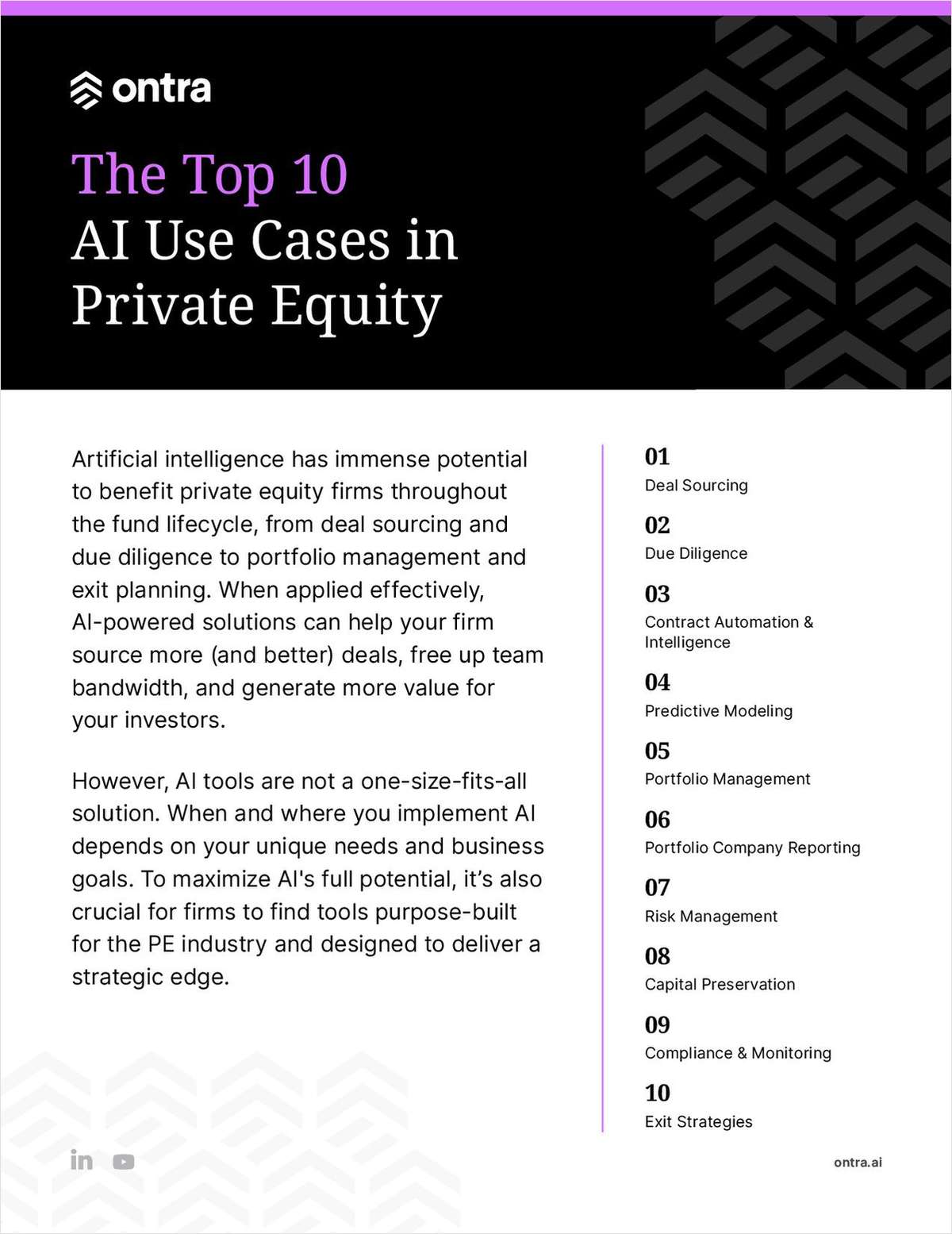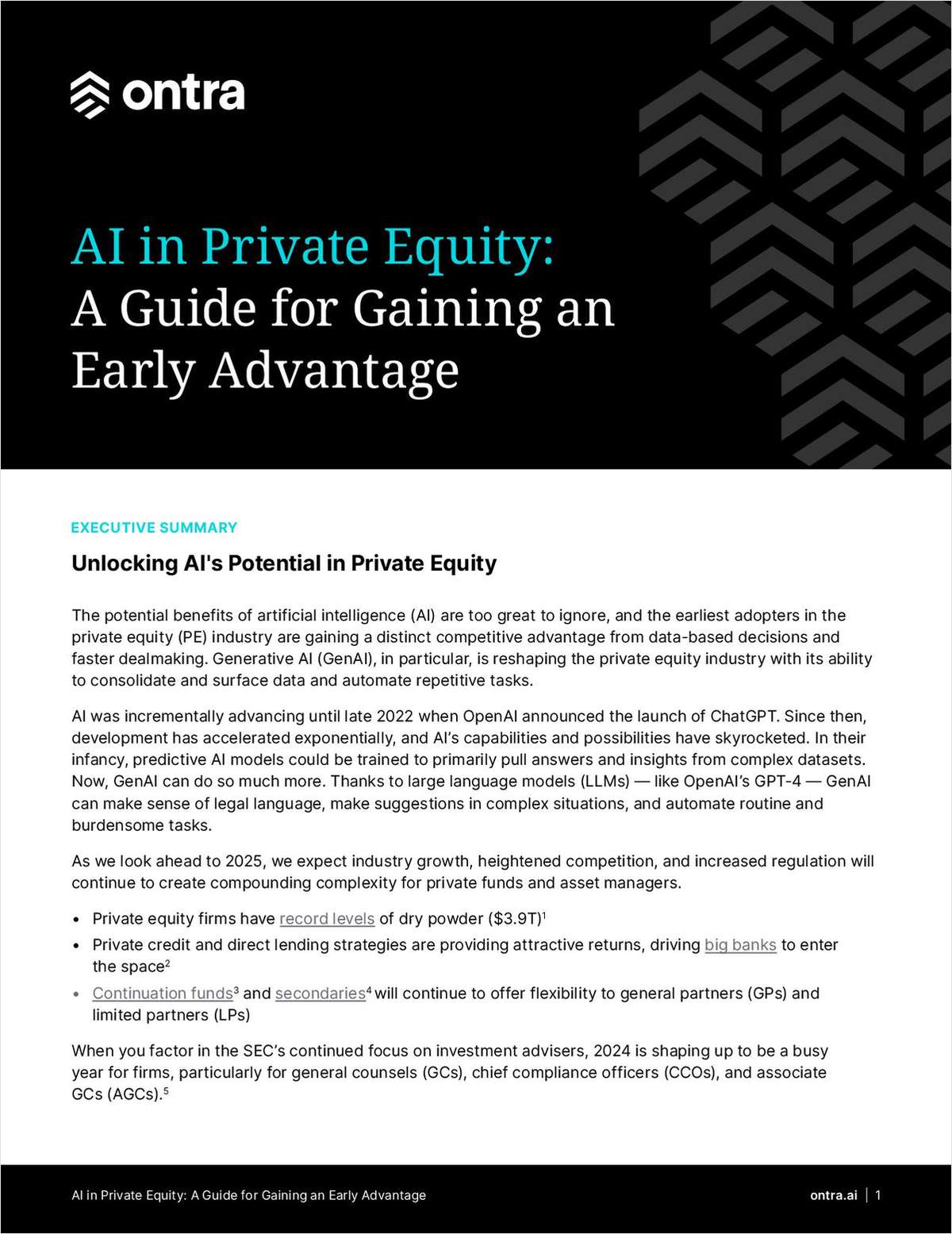Financing the law firm of tomorrow: why external funding is here to stay
Ambitious law firms should be looking beyond their partnership for new sources of capital
August 11, 2016 at 12:00 AM
5 minute read
What would you do if a key competitor raised £50m from private equity or other sources? Where might that leave your firm? And how would you respond?
With competition on the rise, differentiation is everything. It's the holy grail of professional services. So agreeing what genuinely sets your firm apart, how you will demonstrate this and making sure this permeates all teams and activities, is essential.
This needs an agreed strategy and, in most cases, a programme of long-term investment in order to get ahead. And then you need to stay there. Put another way, maintaining the status quo is simply not an option.
Traditionally, finance has been found from partners, bank loans and through finance leases. But with the sums now required, these avenues may be insufficient. The cost of bank lending has also returned to more realistic levels, with increased interest rates eating into margins. This may deter some firms, just at the time they should be seeking funding to invest.
Underwriting almost all development plans is investment in technology. A few years back, IT may have been replaced every five years or so, but now upgrades are required far more regularly just to keep up with the market – never mind getting ahead – and costs are heavy.
So what all this is likely to mean is a need for increased finance, beyond the current typical avenues.
Historically, corporates have accepted that debt is a necessary part of running a business, while partnerships have looked more to partners for finance. This can be structured efficiently but on its own may fall short of the mark.
There is greater acceptance of the merits of debt within the larger law firms as their attitudes move closer to those held by corporates, however there is some way to go. That said, firms' finance teams may not have the background or experience of debt beyond the standard routes. A traditional approach may feel prudent but in the long term, it is likely to prove shortsighted. In a competitive market, this could prove hugely unwise.
At the other end of the scale, firms use bank overdrafts to fund medium- and longer-term projects, such as an office fitout. This can be dangerous: not only are you exposed to high interest rates but overdrafts are repayable on demand, or at best on 30 days' notice, putting the firm in a very precarious position. You should be focusing on your clients, not potentially dealing with urgent bank demands.
The most ambitious firms will, in my view, be increasingly forced to look beyond the partnership to more structured debt, external investors, or even the stock market. While the Legal Services Act has not had the impact many expected, it is affecting the retail and commoditised end of the legal market, where hefty investment into IT systems can bring rewards. As artificial intelligence gradually improves, these trends will impact the whole legal market.
Such firms are, and will be, run on corporate lines, typically led by a professional CEO with a very clearly defined plan. External investors may accept that the early years will be loss-making as the business scales up, but will expect them to gain market share and generate returns.
I am often asked about the best business structure. From 2000 onwards, firms were keen to convert to LLP status, and now we are seeing an increasing number set up as a corporate, while a handful are PLCs or a combination of structures. Operating as a company may offer access to alternative structuring of funding but it is not a prerequisite, and the firm's culture is an essential part of the decision-making process.
Looking at the top 50 as a whole and this year's table, we see an overall drop in borrowing for 2014-15. Taken together, we calculate that bank loans and overdrafts decreased from around £703m to about £643m (across all 50 firms), so a fall of around £60m. At the same time, capital from members increased by £54m (across all firms) during the period. This arguably reflects that 2014-15 was a good year, supported by an increase in fee incomes and profitability. However, with clouds gathering on the economic horizon, law firms' confidence may be shortlived, exposing weaknesses and raising the level of competition still further.
So, if you accept the hypothesis that competition will continue to rise in the coming years, just how will you respond? And how will you pay for the investment? In my view, external funding is here to stay. Be sure to make it work for you.
Giles Murphy is head of professional practices at Smith & Williamson.
For more, see Nowhere to hide: UK top 50 LLP accounts analysed.
NOT FOR REPRINT
© 2024 ALM Global, LLC, All Rights Reserved. Request academic re-use from www.copyright.com. All other uses, submit a request to [email protected]. For more information visit Asset & Logo Licensing.
You Might Like
View AllNuix Discover Named a Leader in SoftwareReview's eDiscovery Solutions Data Quadrant for the Second Consecutive Year
Trending Stories
- 1Consumer Cleared to Proceed With Claims Against CVS 'Non-Drowsy' Medication, Judge Says
- 2Ex-Schnader Partner Nears Settlement in Misappropriated Comp Class Action
- 3The Increase in Artificial Intelligence-Related Securities Class Actions
- 4Trump’s DOE Pick Could Spell Trouble for Title IX Enforcement, Higher Ed Funding
- 5Jefferson Doctor Hit With $6.8M Verdict Over Death of 64-Year-Old Cancer Patient
Who Got The Work
Michael G. Bongiorno, Andrew Scott Dulberg and Elizabeth E. Driscoll from Wilmer Cutler Pickering Hale and Dorr have stepped in to represent Symbotic Inc., an A.I.-enabled technology platform that focuses on increasing supply chain efficiency, and other defendants in a pending shareholder derivative lawsuit. The case, filed Oct. 2 in Massachusetts District Court by the Brown Law Firm on behalf of Stephen Austen, accuses certain officers and directors of misleading investors in regard to Symbotic's potential for margin growth by failing to disclose that the company was not equipped to timely deploy its systems or manage expenses through project delays. The case, assigned to U.S. District Judge Nathaniel M. Gorton, is 1:24-cv-12522, Austen v. Cohen et al.
Who Got The Work
Edmund Polubinski and Marie Killmond of Davis Polk & Wardwell have entered appearances for data platform software development company MongoDB and other defendants in a pending shareholder derivative lawsuit. The action, filed Oct. 7 in New York Southern District Court by the Brown Law Firm, accuses the company's directors and/or officers of falsely expressing confidence in the company’s restructuring of its sales incentive plan and downplaying the severity of decreases in its upfront commitments. The case is 1:24-cv-07594, Roy v. Ittycheria et al.
Who Got The Work
Amy O. Bruchs and Kurt F. Ellison of Michael Best & Friedrich have entered appearances for Epic Systems Corp. in a pending employment discrimination lawsuit. The suit was filed Sept. 7 in Wisconsin Western District Court by Levine Eisberner LLC and Siri & Glimstad on behalf of a project manager who claims that he was wrongfully terminated after applying for a religious exemption to the defendant's COVID-19 vaccine mandate. The case, assigned to U.S. Magistrate Judge Anita Marie Boor, is 3:24-cv-00630, Secker, Nathan v. Epic Systems Corporation.
Who Got The Work
David X. Sullivan, Thomas J. Finn and Gregory A. Hall from McCarter & English have entered appearances for Sunrun Installation Services in a pending civil rights lawsuit. The complaint was filed Sept. 4 in Connecticut District Court by attorney Robert M. Berke on behalf of former employee George Edward Steins, who was arrested and charged with employing an unregistered home improvement salesperson. The complaint alleges that had Sunrun informed the Connecticut Department of Consumer Protection that the plaintiff's employment had ended in 2017 and that he no longer held Sunrun's home improvement contractor license, he would not have been hit with charges, which were dismissed in May 2024. The case, assigned to U.S. District Judge Jeffrey A. Meyer, is 3:24-cv-01423, Steins v. Sunrun, Inc. et al.
Who Got The Work
Greenberg Traurig shareholder Joshua L. Raskin has entered an appearance for boohoo.com UK Ltd. in a pending patent infringement lawsuit. The suit, filed Sept. 3 in Texas Eastern District Court by Rozier Hardt McDonough on behalf of Alto Dynamics, asserts five patents related to an online shopping platform. The case, assigned to U.S. District Judge Rodney Gilstrap, is 2:24-cv-00719, Alto Dynamics, LLC v. boohoo.com UK Limited.
Featured Firms
Law Offices of Gary Martin Hays & Associates, P.C.
(470) 294-1674
Law Offices of Mark E. Salomone
(857) 444-6468
Smith & Hassler
(713) 739-1250













